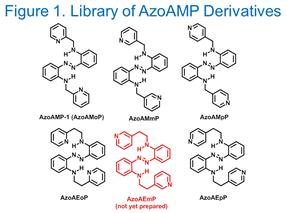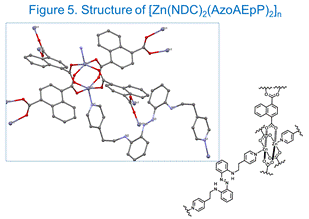Reports: ND353977-ND3: Photo-Functional Switches and Metal Organic Frameworks Containing Azobenzene Groups
Shawn Burdette, PhD, Worcester Polytechnic Institute
The following specific aims were proposed originally:
1. Identify a modification strategy for converting an inactive AB into a one that undergoes isomerization
2. Design a chelator where coordination traps AB in the cis form
3. Design AB ligands that serve as the core for MOFs
4. Determine the extent to which functionalized ABs can assemble MOFs from dinuclear paddle-wheel cores
Research activities in 2015 were primarily focused aim 3 and 4 building on the results from last funding period to finish characterization of materials for publication.
3. Design AB ligands that serve as the core for MOFs.
In the original proposal, we described a series of 6 azobenzened-based ligands that we envisioned as components of MOFs, and in preliminary results described the synthesis of 5 ligands and the corresponding silver complexes (Figure 1). As we described in the previous report, we worked to characterize the 2-dimensional polymers, and 3-dimensional MOF structure formed by AzoAEpP (Figure 2). We had noted that this material has interesting optical properties and exhibits luminescence in the solid state and when dispersed in solution. We found all these silver polymers to be remarkably resistant to photoisomerization and photodegredation by high-intensity LED light. We therefore decided to investigate the optical properties further for publication. Figure 3 shows the solid-state absorption spectrum and the fluorescence response of the free ligand and the silver complex.
The free ligand only exhibits luminescence in the solid state and when frozen in a solvent matrix, whereas the Ag polymer is emissive when dispersed in solution. Most azobenzene derivatives are not emissive because of the presence of an interstitial np* state between the p®p* transition that would lead to fluorescence. To understand why the ligands/polymers are emissive, we initiated a collaboration with François-Xavier Coudert’s research group at Chimie ParisTech to do computational investigations. The Coudert group’s calculations suggest that the hydrogen bonds between the aniline hydrogen atoms and the diazene core of the azobenzene ligand, stabilizes the orbital that gives rise to the np* state below the p®p* transition, which removes the non-radiative decay pathway for excited state and opens the emission channel. We are currently in the process of preparing the final manuscript for submission. The only open question we’d like to answer, is why the AzoAEpP complex is significantly more emissive than all the other metal-organic polymers we’ve prepared.
4. Determine the extent to which functionalized ABs can assemble MOFs from dinuclear paddle-wheel cores.
Since we have been focused on completing the silver project, less time has been dedicated to the paddle-wheel MOFs assembled with zinc. Nevertheless, we have been simultaneously collecting data on our existing systems with the bipyridylazobenzene ligands. Figure 5 shows the structure of one of the complexes, and Figure 6 shows representative absorption and emission spectra. We have similar data on five different MOFs, and will transition to assembling manuscripts on this work as soon as the silver work is submitted.

















